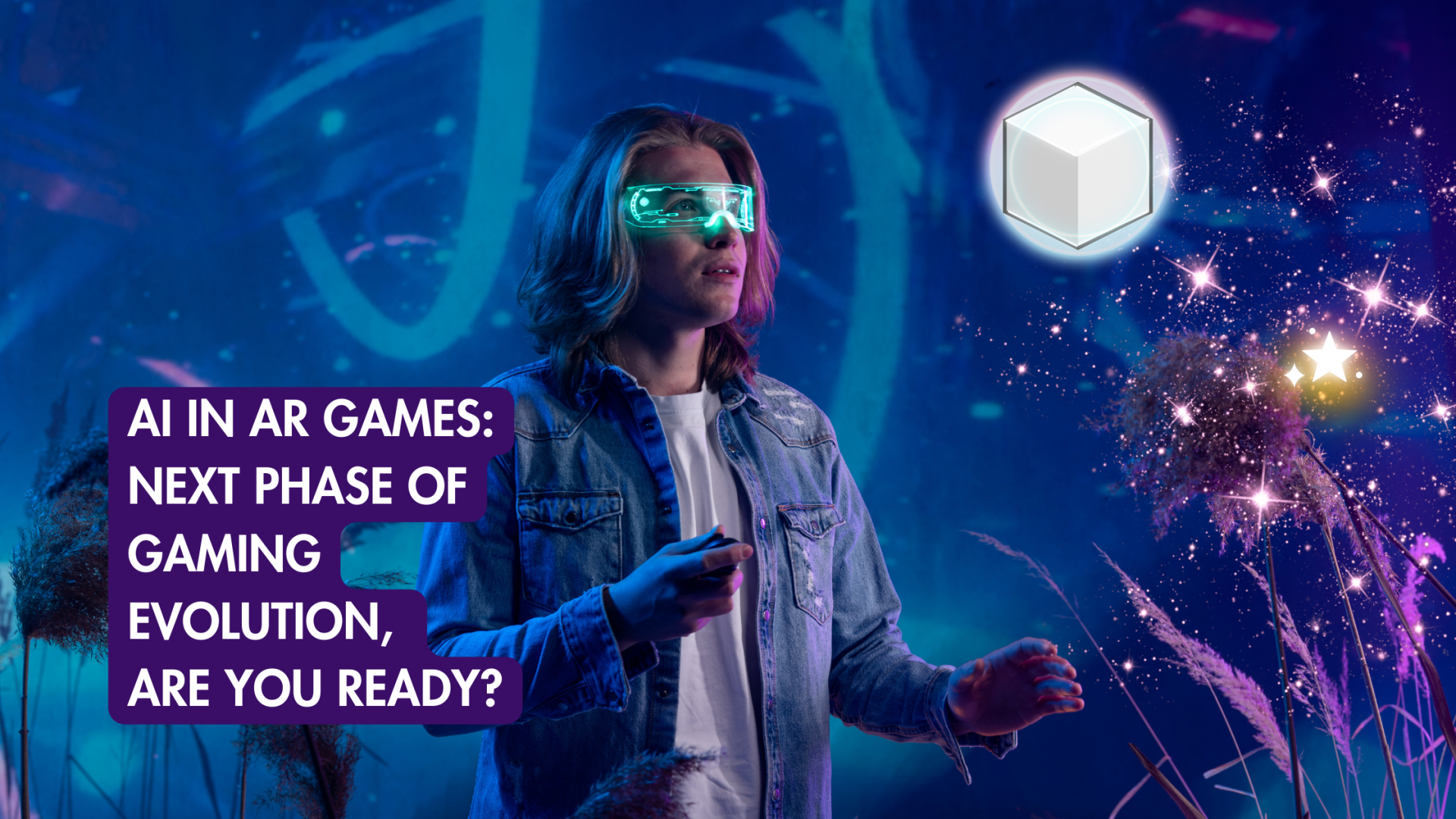Welcome to the second part of our blog, which extensively covers the topic of immersive gaming through the lens of AR games with AI. In the first blog, we thoroughly understood why you should invest in immersive games, what the concept of immersion is, and why immersive gaming is the future. So, if you want to learn about immersion from the basics to the advanced, this blog is your one-stop destination.
Moving on to the second part of the discussion, remember the awe-inspiring transition from 2D to 3D gaming? Well, hold on to your seats, because immersive AI and AR gaming will make an even greater impact.
It is an evolutionary phase that is transforming the gaming space. Smart AI and powerful AR technology are joining forces to engross players in the gaming world. To the extent that the real will become indistinguishable from the virtual.
This discussion will cover every aspect of this new era of immersive AR and AI gaming that has dawned on the gaming space. We will see how AI and AR have converged, what concepts are working behind the scenes, and what’s in it for players and businesses.
Immersive AI-driven AR gaming is here to harmonize the real with the virtual in ways that were once only the stuff of science fiction.
The Convergence of AI and AR in Gaming
Augmented Reality has already made waves across industries and around the world. And now, with the advent of Apple Vision Pro, the technology has become more mainstream than ever.
By overlaying computer-generated digital information over the real world, AR results in an extraordinary fusion of reality and imagination and a genuinely immersive experience.
When it comes to gaming, AR takes the experience beyond the boundaries of non-immersive screens. It transforms the players’ physical surroundings into a three-dimensional theater for digital augmentation. As a result, players see, hear, touch, and, best of all, interact with the gaming elements as if they are right there in the real world.
So, how does it achieve the said outcomes?
AR technology employs sophisticated cameras and sensors to scan and map the physical surroundings. This gives the digital world a nuanced understanding of the geometry of users’ environments. The result? Virtual objects find a fitting place and get gelled into users’ realities, creating a unique user experience.
AI in AR Gaming
On the flip side, Artificial intelligence, or AI, breathes life into these augmented realms. With complex and powerful algorithms and an effective data-intensive approach, AI enhances the interactions between users and the digital element.
It uses computer vision algorithms for real-world object recognition and tracking, improving responsiveness and user experiences. This includes understanding users’ gestures in the real world to manipulate objects in the virtual world.
AI understands voice commands using natural language processing (NLP), making it an amazing gaming buddy.
But that’s not it. The best advantage of AI in AR gaming is that it makes that game unique and personalized for each gamer. It keeps tracking players’ progress through the game, learning about their preferences, likes, and dislikes. Over time, it adapts to their individual gaming style, bringing the best possible gaming experience to their disposal.
Essentially, both of these pioneering technologies work together to create AI and AR games for the most personalized, immersive, and enjoyable gaming experience. They have tons of novel features to offer. Here is a discussion of them one by one:
Immersion: The New Standard in Gaming
This is the most important feature of AI and AR games that makes them stand out from other gaming experiences. That is why we covered it in detail in the previous blog. Read that here.
However, to brush up on your understanding quickly, here is a short discussion on immersion.
Immersion refers to the degree to which the virtual elements seamlessly blend with the real-world environment. In AI-AR gaming, you’re not playing the game but living the adventure.
This immersion is fueled by a quintet of components: spatial integration, interactivity, realism and detail, consistency, and personalization.
Spatial Integration
The foundation that transforms your surroundings into a 3D canvas is spatial integration. It ensures that digital objects or creatures appear to exist in the same physical space as you do, allowing you to interact with them as if they were truly there.
This component creates a bridge between the virtual and real worlds, enabling you to explore and engage with your surroundings in entirely new ways.
Interactivity
Secondly, Interactivity is the magic that bridges the gap between you and the AR experience. It’s the sensation of reaching out and touching, swiping, or gesturing within this alternate dimension. Interactivity is what enables you to wield a virtual sword, cast spells with a flick of your wrist, or solve puzzles with your fingertips.
It’s the dynamic interchange between your actions and the response from the AR world that makes you an active participant rather than a passive observer. This component transforms AR gaming into a visceral, hands-on adventure where your choices and movements shape the unfolding narrative.
Realism and Detail
Realism takes the digital and makes it tangible. In such settings, virtual shadows align with real light sources, and virtual water ripples just like in the real world. These details add finesse, turning textures into touchable realities and lighting into artistry.
Detail is the intricate touch that breathes life into the augmented reality experience. It’s the artistry in tiny elements that makes the digital world feel real. It’s the way virtual raindrops and wind mimic the physical world, turning textures into touchable realities. Detail ensures that every aspect, from pixels to sound, is crafted to replicate reality, creating a truly immersive connection with the augmented world.
Consistency
Consistency is the glue that binds you to this parallel reality. When the virtual world behaves logically, follows the laws of physics, and responds to your actions predictably, you’re submerged in a space that mirrors your expectations.
Personalization
For personalization, the game adjusts its challenges to match the player’s skill levels, choices, and preferences. By analyzing your behavior, AI shapes the game to fit your gaming persona. It’s like having a game that grows with you, always offering the perfect balance of challenge and excitement. Case in point: immersive AR RPGs that craft quests and challenges designed just for you.

Procedural Content Generation: Infinite Possibilities
The second feature of AR gaming with AI is Procedural Content Generation. It is a revolutionary concept that has taken the gaming industry by storm. Imagine taking on a gaming journey where each playthrough leads you into an entirely distinct and uncharted environment.
This dynamic feature keeps players consistently engaged and entranced by the virtual worlds they explore. The magic of procedural content generation lies in its ability to create game content on the fly with the assistance of AI algorithms.
On the face of it, the concepts of personalization and PCG may appear similar, but there are certain differences:
Key Differences between Personalization and Procedural Content Generation:
- Player-Centric vs. Content-Centric: Personalization focuses on adapting the game experience to suit the player, while procedural content generation focuses on creating game content dynamically.
- Purpose: Personalization aims to enhance player engagement and enjoyment by catering to individual preferences. Procedural content generation aims to provide variety and replayability by generating content algorithmically.
- Control: Personalization relies on developer-defined rules and AI analysis to tailor the game experience. Procedural content generation relies on mathematical algorithms to generate content without developer intervention.
- Examples: Personalization is often seen in games that adjust difficulty, story choices, or in-game recommendations. Procedural content generation is commonly used in games with dynamically generated worlds or levels.
Coming to the benefits of procedural content generation. These are two-fold:
Endless Exploration:
With AI-driven procedural content generation, players are no longer bound by a static game world. The possibilities become virtually limitless, as each playthrough promises a unique masterpiece waiting to be discovered. This consistent evolution ensures that the gaming experience remains unpredictable and exhilarating, effectively eradicating the dreaded specter of boredom.
Enhanced Engagement:
As players venture into ever-changing dungeons in AR adventure games, the sense of discovery and exploration becomes a driving force. This heightened engagement stems from the anticipation of what’s next, elevating the overall gaming experience to new heights.
Smart NPC Interaction: Bringing Virtual Worlds to Life
In contrast to traditional Non-playable Characters (NPCs) governed by pre-set codes, these AI-driven NPCs are more akin to trusted friends in your gaming journey. These NPC’s can detect a player’s excitement and respond with enthusiasm. This real-time interaction isn’t confined to mere gaming; it creates an avenue for genuine conversations with the virtual realm.
Immersive Engagement:
With smart NPCs, players forge an emotional connection that enhances immersion. This level of interaction deepens the player’s attachment to the game world, making the experience all the more captivating and personal.
Dynamic Storytelling:
Real-time interactions enable AI NPCs to respond to players’ choices, emotions, and cues. This opens the door to dynamic storytelling, where the narrative adapts organically based on the player’s interactions. It’s a game-changer that makes every playthrough a unique narrative experience.
Predictive Analytics: Anticipating Your Next Move
Ever wish that the game knew exactly what you were thinking? AI’s predictive analytics transform that wish into a reality. By delving into your past actions and decisions, the AI predicts your preferences and tailors the game’s content to perfectly align with them.
But predictive analytics is more than just providing what you want; it’s about creating a narrative that resonates deeply with your choices. Imagine an AR adventure game where the storyline branches out based on your personality traits. This personalized touch elevates the game from a mere pastime to a journey that mirrors your individuality.
Personalized Experiences:
Predictive analytics create a tailored gameplay experience that reflects your unique preferences. This personal touch enhances player satisfaction, as the game adapts to your tastes, making every moment more enjoyable.
Emotional Engagement:
The power of a narrative that aligns with your choices evokes a strong emotional connection. Players become invested in the game’s outcome, heightening the emotional impact and making the gaming journey all the more memorable.
Incorporating these concepts into your gaming venture doesn’t just enhance gameplay; it transforms it into an immersive adventure tailored to individual players. The fusion of AI and AR not only enriches player experiences but also propels gaming businesses into an era of innovation and limitless possibilities.
Why Invest in Immersive AI and AR Gaming Now?

The gaming industry is evolving at a breathtaking pace, and immersive AI and AR gaming are at the forefront of this evolution. Players are hungry for experiences that take them into the gaming world.
They want to wield swords, solve mysteries, and shape narratives like never before. This is where your investment opportunity lies. As business decision-makers and investors, you have the chance to shape the future of entertainment.
With AR gaming projected to surge in popularity, embracing the immersive era is more than just a strategic move; it’s a leap into the forefront of innovation. When you invest in immersive AI and AR gaming, you’re investing in the dreams and desires of millions of players who crave more than just screens; they want adventures that come to life.
The potential of AR Games with AI is immense. Besides the discussed immersive experience, here’s how it could reshape the gaming industry:
Social Gaming Revolution
The convergence of AR Games with AI has the potential to spark a remarkable evolution in social gaming. Visualize a scenario where friends come together to combat virtual foes invading their local park or engage in exciting AR duels against each other in familiar surroundings.
With AI and AR driving this transformation, gaming experiences evolve into collaborative adventures, fostering stronger connections and leaving players with memories that bridge the gap between virtual and real life.
For businesses, the social gaming revolution presents an array of investment opportunities. They can integrate products or services into the AR gaming experience and create o immersive marketing campaigns.
Businesses can create in-game quests or events tied to real-world locations to enhance foot traffic and engagement.
Moreover, developing multiplayer AR games with AI can tap into the rising trend of social gaming, potentially yielding substantial returns on investment.
Physical Activity Integration
The fusion of AI and AR has the potential to reshape our approach to physical fitness through Fitness AR games. These games, already gaining popularity, hold the promise to revolutionize how we engage in physical activity.
AI algorithms could tailor workout routines to suit individual needs, monitor progress, and provide personalized motivation, effectively blurring the boundary between exercise routines and enjoyable gaming sessions.
For businesses eyeing opportunities in the health and wellness sector, investing in AR fitness games is a strategic move.
Offering virtual workout equipment or accessories that synchronize seamlessly with fitness AR games can create a new market segment.
Establishing partnerships with gyms and health clubs to provide exclusive in-game incentives tied to real-world visits can boost brand exposure and customer engagement.
This investment approach aligns with the growing trend of integrating technology with health and well-being.
Educational Opportunities
AI-powered AR in gaming paves the way for innovative educational opportunities. Imagine a scenario where students are transported through time with AR simulations, experiencing historical events firsthand.
AI algorithms can adapt the learning journey based on individual learning styles, ensuring an engaging and effective educational experience.
The realm of education offers significant investment potential for businesses seeking to support educational innovation. By collaborating with educational institutions, businesses can create immersive educational content that could lead to impactful partnerships.
Investing in the development of educational AR games that align with curriculum standards and enhance learning outcomes presents an avenue to contribute to the future of education while potentially reaping financial rewards.
New Monetization Models
The integration of AI and AR in gaming introduces novel monetization models that cater to players and businesses alike. Location-based advertising seamlessly embedded within the gaming environment presents a unique way for brands to connect with their target audience. In-game purchases linked to real-world interactions offer players value-driven opportunities to enhance their experiences while providing businesses with diversified revenue streams.
Investing in the exploration of new monetization avenues in AR Games is a strategic move for businesses aiming to tap into innovative revenue streams. Creating partnerships with game developers to incorporate branded content or rewards into AR games can establish a lasting presence in the gaming ecosystem.
Exploring possibilities for in-game purchases tied to real-world interactions offers the potential for substantial returns on investment while also contributing to enhanced player engagement.
As AI and AR continue to shape the future of gaming, businesses that recognize and seize these investment opportunities position themselves at the forefront of innovation. The potential to engage players in new and captivating ways while generating revenue streams presents a compelling case for strategic investments in the evolving landscape of immersive gaming.
Get your own AI-powered AR Game in minutes
Vossle is an AI-enabled SAAS platform that allows you to create your very own AR games in a matter of minutes. All you need is to:
- Sign up
- Use AI assistance,
- Upload your 3D models
- Adjust some settings
- Click “Submit”, and it’s ready!
Conclusion: Embrace the Immersive Future
Gaming has always been about pushing boundaries and defying limits. With immersive AI and AR gaming, those boundaries are evaporating, and the limits are being rewritten.
This process involved a lot of different concepts working together for a perfect user experience.
We stand at the threshold of a new era where the impossible becomes possible, and the fantastic becomes reality. As a business decision-maker or investor, the question is no longer “Are you ready?—it’s “How will you shape this immersive future?”



















